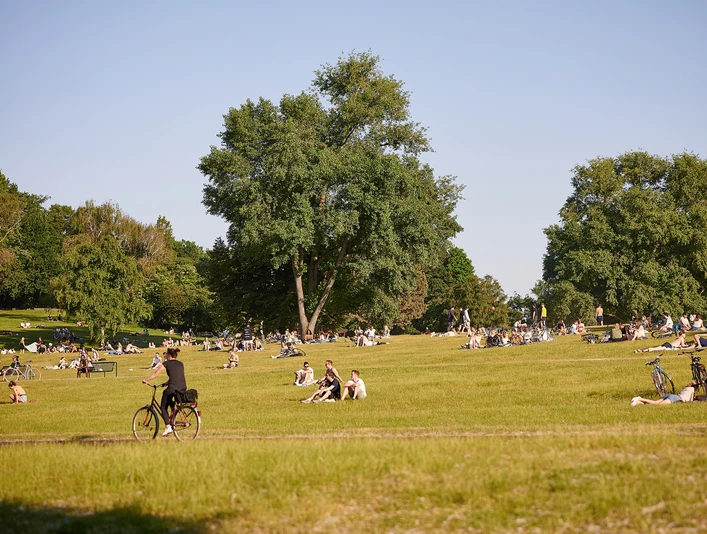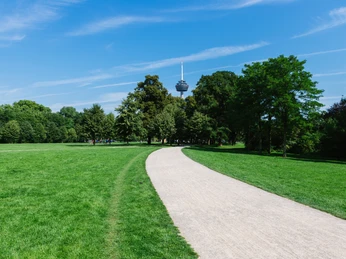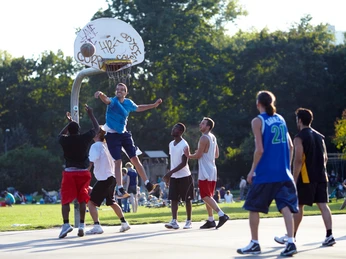- Photos & Map
How would you like to arrive?
- Details
- Useful Information
- Nearby
Two semicircular green belts that arc around Cologne on both sides of the Rhine—to invigorate residents and visitors and provide an expansive oasis amid the colorful hustle and bustle of city life: these are the Cologne Green Belts. Both rings were created in 1920 on the grounds of the former 19th century fortifications under Konrad Adenauer.
The Inner Green Belt is regarded as the largest park in the heart of Cologne, stretching seven kilometers in length, 200 meters in width, and covering an area of 120 hectares. Even larger is the second belt, which spans 800 hectares. In the extensive area of the Outer Park Belt, in addition to the remains of the fortifications, there are open meadows and bodies of water such as the Adenauer Pond, the Kalscheurer Pond, and the Decksteiner Pond. Therefore, there are plenty of opportunities for local recreation, extended walks, and the possibility to retreat into the city's hustle at any time for your outing spirit.
The Green Belt invites you to take longer walks amid greenery, yet right in the city. One could start, for instance, at the Volksgarten, where the park areas around Fort IV represent one of the earliest and most formative landscape designs by Adolf Kowallek. These areas provide an impressive backdrop that skillfully connects historical fortification buildings with attractively designed gardens. Although the railway line visually separates the Green Belt in some places, at the Rhine bank near the Friedenspark around Fort I, there is once again an opportunity to linger amidst flower gardens on the preserved fortification terraces.
Between these historical fortifications, there are spacious park and meadow areas that offer an ideal ambiance for a quiet afternoon outdoors. The Aachener Weiher, surrounded by meticulously laid-out paths, reflects the geometric garden art of its time.
In Cologne-Nippes, the small park on Escher Street, popularly known as "Alhambra," features a strictly symmetrical "sunken garden." Despite the now dry fountains, the garden maintains its structure and offers a quiet oasis for reflection. Older trees border the area, creating shaded spots for peace and quiet.
Additionally, since 2018, the section of the Green Belt named after Carola Williams between Aachener Street and Vogelsanger Street honors a personality who shaped the development of the area. This part of the Green Belt symbolizes the continuous development and cultural significance of Cologne's green lung.
The Green Belt, whose opening was celebrated in 1923, originally served the purpose of providing open spaces for sports and recreation. Extensive green areas were planned, comprising sports and playing fields, school gardens, forest schools, air baths, and flower gardens. Today, the area offers a wide range of recreational opportunities, including extensive walking and cycling paths.
Along the Military Ring, which runs through the entire Outer Green Belt, there are small parcel gardens and allotments as well as numerous cemeteries. On the other side of the ring, a forest strip traversed by old fortification works stretches, leading to open meadows and embedded water bodies such as the Kalscheurer Pond, the Decksteiner Pond, and the Adenauer Pond. These waters, with hillocks raised from their excavation, offer idyllic landscapes inviting you to spend relaxed hours in the heart of nature.
The innovative side of the Outer Green Belt is manifested in the Forest Laboratory established in 2010 near the Decksteiner Pond. Here, in collaboration with the Cologne Forestry Administration and with the support of sponsors, methods to adapt the forest to climate change are being researched.
The Inner Green Belt is regarded as the largest park in the heart of Cologne, stretching seven kilometers in length, 200 meters in width, and covering an area of 120 hectares. Even larger is the second belt, which spans 800 hectares. In the extensive area of the Outer Park Belt, in addition to the remains of the fortifications, there are open meadows and bodies of water such as the Adenauer Pond, the Kalscheurer Pond, and the Decksteiner Pond. Therefore, there are plenty of opportunities for local recreation, extended walks, and the possibility to retreat into the city's hustle at any time for your outing spirit.
Inner Green Belt: From Volksgarten to Aachener Weiher
The Inner Green Belt stretches along the Rhine bank from Cologne-Riehl to Luxemburger Street. This green fringe of the city, whose origins date back to the 1920s, elegantly combines historical heritage with urban nature.The Green Belt invites you to take longer walks amid greenery, yet right in the city. One could start, for instance, at the Volksgarten, where the park areas around Fort IV represent one of the earliest and most formative landscape designs by Adolf Kowallek. These areas provide an impressive backdrop that skillfully connects historical fortification buildings with attractively designed gardens. Although the railway line visually separates the Green Belt in some places, at the Rhine bank near the Friedenspark around Fort I, there is once again an opportunity to linger amidst flower gardens on the preserved fortification terraces.
Between these historical fortifications, there are spacious park and meadow areas that offer an ideal ambiance for a quiet afternoon outdoors. The Aachener Weiher, surrounded by meticulously laid-out paths, reflects the geometric garden art of its time.
Inner Green Belt: From the University to Nippes
The neighboring University of Cologne, which has expanded in this area since the 1920s, adds an academic touch and illustrates the symbiosis of education and recreation. The Universitätsstraße, which borders the Green Belt toward the city, also marks an interface between urban hustle and the tranquility of the Green Belt.In Cologne-Nippes, the small park on Escher Street, popularly known as "Alhambra," features a strictly symmetrical "sunken garden." Despite the now dry fountains, the garden maintains its structure and offers a quiet oasis for reflection. Older trees border the area, creating shaded spots for peace and quiet.
Additionally, since 2018, the section of the Green Belt named after Carola Williams between Aachener Street and Vogelsanger Street honors a personality who shaped the development of the area. This part of the Green Belt symbolizes the continuous development and cultural significance of Cologne's green lung.
Outer Green Belt: Along the Military Ring
The Outer Green Belt extends far beyond the boundaries of the original city area. Created in the early 20th century, it covers an impressive area of about 800 hectares, with 400 hectares featuring extensive forest areas.The Green Belt, whose opening was celebrated in 1923, originally served the purpose of providing open spaces for sports and recreation. Extensive green areas were planned, comprising sports and playing fields, school gardens, forest schools, air baths, and flower gardens. Today, the area offers a wide range of recreational opportunities, including extensive walking and cycling paths.
Along the Military Ring, which runs through the entire Outer Green Belt, there are small parcel gardens and allotments as well as numerous cemeteries. On the other side of the ring, a forest strip traversed by old fortification works stretches, leading to open meadows and embedded water bodies such as the Kalscheurer Pond, the Decksteiner Pond, and the Adenauer Pond. These waters, with hillocks raised from their excavation, offer idyllic landscapes inviting you to spend relaxed hours in the heart of nature.
Outer Green Belt: The Landscape Park
A particularly prominent area is the Landscape Park between Aachener Street and Bonner Street, which is a popular recreational destination for both Cologne residents and visitors from the surrounding area. A comprehensive sports center is also located here.The innovative side of the Outer Green Belt is manifested in the Forest Laboratory established in 2010 near the Decksteiner Pond. Here, in collaboration with the Cologne Forestry Administration and with the support of sponsors, methods to adapt the forest to climate change are being researched.
Useful Information
Payment methods
Entrance Free
Nearby


